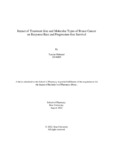| dc.contributor.advisor | Azam, Faruque | |
| dc.contributor.author | Mahmud, Tanzim | |
| dc.date.accessioned | 2023-07-09T09:56:05Z | |
| dc.date.available | 2023-07-09T09:56:05Z | |
| dc.date.copyright | 2022 | |
| dc.date.issued | 2022-08 | |
| dc.identifier.other | ID: 18146005 | |
| dc.identifier.uri | http://hdl.handle.net/10361/18694 | |
| dc.description | This thesis is submitted in partial fulfillment of the requirements for the degree of Bachelor of Pharmacy, 2022. | en_US |
| dc.description | Cataloged from PDF version of thesis. | |
| dc.description | Includes bibliographical references (pages 16-17). | |
| dc.description.abstract | According to the American Cancer Society's projections, there will be 339,250 cases of breast
cancer and 43,250 women will pass away due to this cancer in the year 2022. Moreover, breast
cancer is responsible for 15% of all cancer deaths. Cancer treatments are approved in the market
after successfully passing through Phase III clinical trials. However, most of the cancer drugs
fail in the real world despite showing promising efficacy in the clinical trials. We have collected
95 PFS (progression free survival) and ORR (overall response rate) data of different breast
cancer molecular subtypes from 140 extracted articles reporting Phase II clinical trials. We
have observed how the PFS and ORR values change in response to the combination size and
different breast cancer subtypes as well. We have found a moderate positive correlation (r =
0.57) between PFS and ORR. Also, the PFS and ORR increase when treatment number in
combination is increased. The highest ORR and PFS values are observed under HER2+
(Human epidermal growth factor receptor 2- positive) subtype in our research. On the contrary,
these values were significantly lower for HR+ (Hormone receptor-positive) and TNBC (Triple
negative breast cancer). Our study will certainly help clinical trial researchers to better
understand how PFS and ORR vary in response to tumor subtypes and combination size. | en_US |
| dc.description.statementofresponsibility | Tanzim Mahmud | |
| dc.format.extent | 17 pages | |
| dc.language.iso | en | en_US |
| dc.publisher | Brac University | en_US |
| dc.rights | Brac University theses are protected by copyright. They may be viewed from this source for any purpose, but reproduction or distribution in any format is prohibited without written permission. | |
| dc.subject | Breast cancer | en_US |
| dc.subject | PFS | en_US |
| dc.subject | ORR | en_US |
| dc.subject | HR+ subtype | en_US |
| dc.subject | HER2+ subtype | en_US |
| dc.subject | TNBC subtype | en_US |
| dc.subject | Combination size | en_US |
| dc.subject.lcsh | Breast--Cancer--Patients | |
| dc.subject.lcsh | Breast--Cancer--Treatment | |
| dc.title | Impact of treatment size and molecular types of breast cancer on response rate and progression-free survival | en_US |
| dc.type | Thesis | en_US |
| dc.contributor.department | Department of Pharmacy, Brac University | |
| dc.description.degree | B. Pharmacy | |

